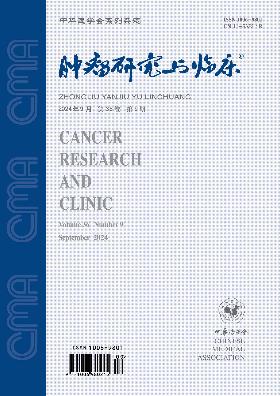可切除肺癌预后预测模型的建立及生存分析
Q4 Medicine
引用次数: 0
摘要
目的探讨构建的可切除肺癌预后预测模型在预测患者生存及预后方面的价值。方法选取2007年1月至2018年9月山西省肿瘤医院原发性肺癌患者2 267例。所有患者均行无第二原发肿瘤的原发性肺癌手术。选择性别、年龄、职业、肿瘤部位、病理类型、手术路径、手术方式、肿瘤分期及治疗作为影响预后的因素。采用Cox比例风险模型构建预后指数(PI)方程,计算每位患者的PI值。根据PI值的不同范围分为低、中、高危预后组,评估三组患者的生存状况。结果性别(RR= 0.684, P= 0.001)、年龄(RR= 0.591, P -0.5)为高危组,其生存率差异有统计学意义(P < 0.05)。低危组的1、3、5年生存率分别为96.8%、87.0%和77.9%;中危组分别为91.8%、82.2%和61.7%;高危组分别为86.5%、61.7%和50.3%。分别。结论可切除肺癌预后预测模型可预测可切除肺癌患者的预后风险及相应的生存率,可帮助临床医生评估预后并制定后续治疗方案。关键词:肺肿瘤;胸外科手术;预后;遗传模型;生存分析本文章由计算机程序翻译,如有差异,请以英文原文为准。
Construction of prognostic prediction model of resectable lung cancer and survival analysis
Objective
To explore the value of the constructed prognostic prediction model of resectable lung cancer in predicting the survival and prognosis of patients.
Methods
A total of 2 267 patients with primary lung cancer in Shanxi Provincial Cancer Hospital from January 2007 to September 2018 were selected. All patients underwent primary lung cancer surgery without a second primary tumor. Gender, age, occupation, tumor site, pathological type, surgical path, surgical method, tumor stage and treatment were selected as the prognostic factors. A Cox proportional hazard model was used to construct a prognostic index (PI) equation to calculate the PI value of each patient. According to the different ranges of PI values, the low-, intermediate- and high-risk prognosis groups were divided, and the survival status of three groups were evaluated.
Results
Gender (RR= 0.684, P= 0.001), age (RR= 0.591, P -0.5 was the high-risk group, and the differences of their survival rates were statistically significant (P < 0.05). The 1-, 3-, and 5-year survival rates for the low-, risk groups were 96.8%, 87.0% and 77.9%; the intermediate-risk group were 91.8%, 82.2% and 61.7%; the high-risk group were 86.5%, 61.7% and 50.3%. respectively.
Conclusion
The prognostic prediction model of resectable lung cancer can predict the prognosis risk and the corresponding survival rate of patients with resectable lung cancer, and it can help clinicians to evaluate the prognosis and formulate subsequent treatment plans.
Key words:
Lung neoplasms; Thoracic surgical procedures; Prognosis; Models, genetic; Survival analysis
求助全文
通过发布文献求助,成功后即可免费获取论文全文。
去求助
来源期刊

肿瘤研究与临床
Medicine-Oncology
CiteScore
0.10
自引率
0.00%
发文量
7737
期刊介绍:
"Cancer Research and Clinic" is a series of magazines of the Chinese Medical Association under the supervision of the National Health Commission and sponsored by the Chinese Medical Association.
It mainly reflects scientific research results and academic trends in the field of malignant tumors. The main columns include monographs, guidelines and consensus, standards and norms, treatises, short treatises, survey reports, reviews, clinical pathology (case) discussions, case reports, etc. The readers are middle- and senior-level medical staff engaged in basic research and clinical work on malignant tumors.
 求助内容:
求助内容: 应助结果提醒方式:
应助结果提醒方式:


